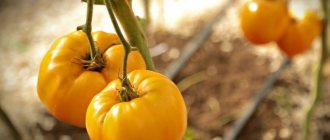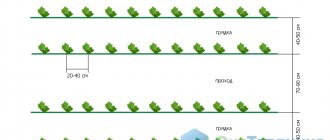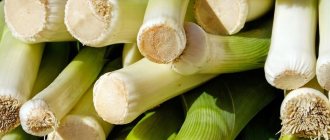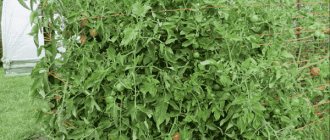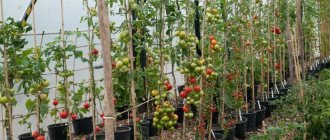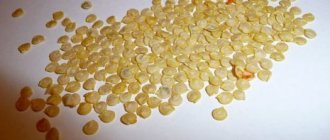Preparing the soil and properly making beds for tomatoes are two main points that experienced summer residents recommend approaching as responsibly as possible. It is not for nothing that there is a saying that a spring day feeds the whole year. For summer residents, this expression is a kind of law, as a result of which, with the arrival of the first warm days, they all go to their summer cottages. No weather conditions can prevent the opening of the summer season. During this period, it is important not only to properly prepare the soil for planting crops, but also to make beds for planting tomatoes. You can complete all the work much faster if you adhere to certain recommendations and advice from summer residents and follow a step-by-step algorithm.
Timing for planting tomato seedlings
Tomato seedlings are planted in a permanent place in the ground when they reach a certain age (and it is different for each variety), depending on the region, the climate and the danger of return frosts: at 0 - +2 degrees, the seedlings die if they are not protected.
Days of planting seedlings in different regions of Russia
| Region | Time for planting seedlings |
| Moscow region | Second half of May |
| Siberia and the Urals | The beginning of June |
| South of Russia | Second half of April |
| Northwest | June 2-10 |
Tomatoes are planted in a greenhouse or under film a week earlier.
An ordinary gardener can easily navigate according to the dates given in the table. For perfectionists, it is better to check the soil temperature: by the time of planting, it should warm up to +12 degrees (but this is ideal, +8-10 degrees is acceptable). If the soil is colder, you shouldn’t expect any benefit from planting; the tomatoes will just sit in the ground like bells and get sick until it gets warmer.
The soil temperature is measured at the depth of the planting hole, approximately 20 cm.
How to make beds for tomatoes
Any summer resident wants to bring beauty to his garden. Make decorative flowers with a bountiful tomato harvest. You can prepare a bed for tomatoes in various forms:
- vertical; Pyramid ridges are erected on small plots
- wavy; Wave-shaped ridges are built for mixed plantings
- in the shape of a flower with petals and a circle-middle in the center; The ridges, collected in a single composition, give the site a special coziness
- trapezoidal or triangular boxes. For better illumination of plants, the ridges are placed at an angle
Nasturtiums and marigolds are planted along tomato beds. These flowers repel tomato pests and add decorative beauty to the garden.
Vertical or hanging flower beds are set up next to the flower boxes. Tall ridges are decorated with wattle fence.
Site selection
A place for a warm bed for tomatoes in a greenhouse is chosen taking into account the following factors:
- convenient to approach in any weather;
- good lighting;
- the soil should not be constantly soaked;
- protected from the wind;
- There should not be tall trees nearby that could damage the structure in bad weather.
An open area for arranging a vegetable garden is selected based on:
- should accommodate several beds, convenient approach and row spacing:
- direct or diffuse sunlight;
- well-drained soil;
- no drafts.
Typically, a place for arranging a vegetable garden is chosen in the center of the plot. It is protected along the perimeter by garden plantings and outbuildings.
The most illuminated and wind-protected area is allocated for the vegetable garden.
Attention! When choosing a site for organizing beds, take into account that in the heat the plants need shading, so in the 2nd half of the day there should be shade in the garden area.
Given the shading of the site, neighbors' plants, buildings and fences are taken into account. Before arranging a garden, gardeners observe the amount of shadow cast and take this significant fact into account. They also prefer a flat surface.
Dimensions of beds for tomatoes
Experts recommend maintaining the size of the ridges according to the following parameters:
- The height of the bed is determined by technological necessity. For ordinary fences, a value of 15-20 cm is maintained. High sides of 60-100 cm are made for hot beds. Experts recommend constructing such boxes in the northern regions of the country. The optimal size for the height of a warm rabatka is 70 cm
- Agronomists recommend choosing the width of a bed for tomatoes equal to half a person’s height. This is the most optimal value for ease of plant care. Most often, the width is 80-100 cm. This allows you to reach from the row-spacing to the opposite row of tomatoes for care.
- The length is not limited by anything other than the size of the plot allocated by the summer resident for a vegetable garden. The ridge is placed in a sunny place, which is shaded in the 2nd half of the day. Usually the length of the ridge is made within 3-6 m.
When arranging box beds, the row spacing is taken into account. Usually 30-60 cm are left for it. And if the summer resident plans to transport a wheelbarrow between the rows, then measure the width of the cart, add 10 cm and leave a passage equal to the resulting value.
How to make raised beds for tomatoes
Operating procedure:
- The area is cleared of weeds.
- Level if necessary.
- Dig to a depth of 20-30 cm according to the size of the future beds and lay a protective mesh against rodents.
- A box is made from boards 4-5 cm wide.
- Height 40-100 cm, width 60-100 cm.
- Beams are driven into the corners to secure the boxes to the ridge.
- They begin to layer the organic cake.
- Cover with leaf litter and branches. Covered with earth. Pour in humus and leftover vegetables. Sprinkle earth on top. Add peat, ash and sawdust.
- Each layer is made 10 cm high.
- On top of each tier, earth is poured 5 cm high. The final layer of earth is 20 cm.
The raised bed is thoroughly moistened so that soil bacteria begin to multiply.
If a high bed is prepared in the fall, it is covered with black covering material. In the spring, last year's leaf litter is mainly used to cover the ridge, since there is no other organic matter at this time of year.
Advantages of a raised bed:
- the organic mixture with which the ridges are filled is suitable for growing any vegetable crop, so the summer resident does not depend on the quality of the soil in his personal plot;
- no additional care required;
- no deep digging is required, just loosen the soil with a hand shovel;
- can be moved to any place in the summer cottage if necessary;
- are not clogged with weeds;
- an organic substrate allows you to plant tomato seedlings under a greenhouse in early spring and get the first harvest in May-June;
- look decorative.
The maximum height of a tomato bed is 100 cm. A bed that is too high is not convenient for caring for plants. The optimal height of a warm ridge is 40-60 cm.
How to make a warm bed for tomatoes
Instructions for creating a warm bed for tomatoes with your own hands in the spring:
- Prepare boards with a thickness of 4-5 cm and timber with a cross-section of 5-7 cm.
- Level the area for the ridge.
- Cut boards and beams to size. A corner is attached to the beam.
- Assemble the box and place it level on the bed.
- Along the perimeter from the inside, bars are driven in to hold the sides.
- Drive wedges into the outside of the box so that it does not burst from the substrate.
- Check the sizes. If the diagonals match, it means the box is assembled correctly.
- Lay a protective mesh against rodents and attach it to the bottom board with self-tapping screws.
- Soil and organic fertilizer are poured: manure, leaf litter, peat, etc.
- The arcs are attached on top of the box. Seedlings are planted.
In cool weather, agrofibre is laid on the arches, and in hot weather, a shady mesh
Planting tomatoes: hardening
They begin to harden the seedlings two weeks before planting in a greenhouse or in a greenhouse: they take them out onto a glassed-in loggia (with a temperature of +8-10 degrees) or onto a veranda, first for half an hour, and gradually increase the hardening time until a full day.
A week before planting, tomato seedlings need to be fed. Foliar feeding is preferable (Epin's solution, 1 ml per 5 liters of water, worked well), but any root feeding based on liquid vermicompost is also possible.
To prevent the seedlings from being damaged by the bright spring sun, they are shaded or placed in partial shade.
Advice from experienced gardeners
If you listen to advice and recommendations from experienced gardeners, then you should take into account the following points:
- If you plan to make warm beds for tomatoes yourself, but there is no manure, then an excellent alternative solution is to choose bales with straw. It is recommended to first fill the bales with straw with a solution based on chicken solution, which is made in the ratio: 1 bucket of chicken manure per 50 liters of water ;
- Basil, lettuce, sage, garlic, bell pepper, and onion can be excellent neighbors for tomatoes;
- as practice shows, it is best to plant tomatoes in narrow beds, while the paths are best made wide, this is due to the fact that if the beds are narrow, then it is possible to reach all the tomato bushes without trampling the soil in the beds;
- if the path is wide, this will allow you to stretch the hose for watering the plants without much difficulty;
- when arranging warm beds, it is recommended to first lay a metal mesh with small cells and only then rotted manure; this approach will prevent the penetration of rodents.
Growing tomatoes is not as difficult as it may initially seem, but it will take some effort to get the desired result.
Advice! It is recommended to make the beds so that the sun's rays fall evenly over the entire area. For these purposes, you can make the southern side of the site a little lower.
How to make beds for tomatoes: features of beds, types, sizes. How to make high and warm beds yourself. Preparing beds in spring and autumn. Advice from gardeners.
How to plant tomato seedlings in the ground or greenhouse
Planting seedlings in the ground or greenhouse is carried out either on a cloudy day or in the evening.
Procedure:
- It is good to water the seedlings an hour and a half before planting in order to painlessly remove them from the container;
- Prepare the wells. It is better to do them in a checkerboard pattern: in a row at a distance of 30-40 cm, between rows - 50-70 cm. When planting in parallel, a passage is made every two rows. But these are the distances for medium-sized tomatoes, for tall ones 55-65 cm in a row and 75-95 cm between rows.
- Place arches for shelter.
- Add a tablespoon of wood ash or superphosphate and a little humus, about a handful, to each hole and mix thoroughly with the soil. It is better to pour more soil on top to protect the root system from burns.
- Fill the holes well with water.
- Plant seedlings. It is necessary to bury it either to the cotyledon leaves, or deeper - but then remove the cotyledon leaves.
- Compact the soil around the plant, sprinkle loose soil on top.
- Cover it with something for several days: a box, a box, an old bucket, or even without a bottom - the main thing is to create and maintain a special microclimate around the plant.
When planting tomato seedlings in a greenhouse, adhere to the distances shown in the diagram below.
Immediately after planting, low- or medium-sized seedlings are mulched. Tall seedlings are mulched when they take root.
Mulch can be straw, humus, compost or any other suitable material.
Selecting quality seedlings
You can purchase ready-made seedlings on the market or grow them yourself. In any case, for planting it is necessary to select only those seedlings that have a well-formed root system and a strong stem reaching a height of 20 cm.
It is important that 8-9 full leaves are formed on each shoot. If they have a rich and uniform green color, this is a sure sign of a healthy seedling. Spotting or paleness of greenery indicates that the conditions for growing seedlings have been violated or that they are affected by some kind of disease.
If seedlings are grown independently, it is necessary to observe the correct temperature conditions for each stage of development and sowing dates.
How to adapt seedlings to new conditions
After planting seedlings in the ground, you need to help them adapt to new conditions.
Baba GalyaForumHouse Member
You can apply two layers of covering material at night. Stones, dark plastic bottles with water in the greenhouse. During the day, both heat up and at night, releasing the accumulated heat during the day, they maintain a comfortable temperature.
A good, effective way to help young tomatoes get used to cold nights is newspaper covers. They are put on a stick stuck next to the bush, so that the entire plant is covered.
Fech EvgeniyForumHouse Member
You can put a regular, lit candle under the shelter of the arcs at night.
Seedling care
Proper and timely care of seedlings helps to achieve good fruiting. To develop a strong root system and provide the plant with the necessary amount of oxygen, it is recommended to loosen the bed every 2-3 weeks - the tool is immersed in the soil to a depth of at least 8-10 cm. If the soil is dense enough, this procedure should be carried out more often.
Loosening is often combined with weeding, because weeds can provoke a real pest invasion. Grass retains moisture in the soil, which creates excellent conditions for the development of various diseases. A heavily thickened bed is poorly ventilated.
Watering and fertilizing
Watering should be carried out directly under the root of the plant; do not water the greens. If you choose from existing irrigation systems, it is best to opt for spot irrigation. The use of sprinkling can lead to shedding of inflorescences, causing blanching of the fruits.
After planting, do not water the seedlings too often. It will be enough to perform water procedures several times a week. It is necessary to ensure that the soil does not dry out.
When watering tomatoes, consider the following tips:
- Excessive watering is harmful.
- For watering, use water at room temperature.
- When watering, try not to get it on the trunk and leaves of plants, otherwise it may cause burns.
- Tomatoes need to be watered in the evening, with the exception of hot sunny days.
- Before hilling, during the flowering of the first and second clusters, it is necessary to water the plant.
It is recommended to fertilize tomatoes 4-5 times throughout the entire growing season. Fertilizing is applied according to the following scheme:
- The first time fertilizing is done 15 days after transplanting seedlings into open ground. For this, nutritious infusions of bird droppings or mullein can be used, to which a little wood ash is added. At this time, the bushes begin to gain buds, so applying fertilizer will have a positive effect on the process of formation of fruit ovaries.
- The second feeding is carried out 10 days after the second brush blooms on the bushes. An organic infusion is used with the addition of complex mineral fertilizer in the following proportions - take 1 tbsp per bucket. l. If the tomatoes are tall, add 1.5-2 liters of infusion, for low-growing ones - no more than 1 liter.
- The third feeding should be carried out during the ripening of the first tomatoes. The same nutritional composition is used, but in this case its volume changes - 500 ml of solution is poured under each bush.
- The last feeding is performed 15 days after the third. The ideal option would be to use industrial fertilizer Agricola-3, into which superphosphate is introduced - for every square meter. m 4 liters of solution.
Read more information about feeding tomato seedlings here.
Stepsoning
The formation of side shoots or stepsons must be carried out as the tomato bushes grow. They simply do not have time to ripen, simultaneously drawing out large amounts of nutrients. Therefore, they need to be removed at the early stages of bush development.
2-3 main shoots are left on each plant. By the time the fruits begin to ripen, there should be no stepsons on the bushes. The side shoots, 3-5 cm long, are removed. They need to be broken off or pinched off at a distance of about 1 cm from the main stem. During the procedure, work carefully to avoid leaving large wounds on the plant. It is advisable to perform pinching in the morning.
conclusions
Properly planting tomato seedlings in open ground or in a greenhouse is the key to a good harvest. For everything to go well, you need:
- do not make a mistake with the timing and do not fall into return frosts;
- follow the schemes and do not thicken the plantings;
- prepare the holes correctly and apply all fertilizers;
- bury the plant to a sufficient depth;
- help tomatoes, which have tropical origins, adapt to our cooler nights.
The agricultural technology of tomatoes on FORUMHOUSE is described in great detail; on our portal you will find all the necessary information in this regard. You can find out what fertilizers tomatoes need and how to fertilize them correctly, read an article about how to deal with the most unpleasant disease of tomatoes - late blight. How to stop the “fatification” of tomatoes and generally find the answer to any question about tomato varieties and agricultural technology. And watch our video on how to properly care for tomatoes in the summer.
Subscribe to our Telegram channelExclusive posts every week
Tomato productivity in high beds
Planting tomatoes in high beds and proper care can ensure a great harvest. A high level of organic matter in the soil and good drainage will not only allow you to spend less time caring for tomatoes, but will also produce large fruits and a large number of bunches.
Another factor in a rich harvest is good access to land for weeding. The absence of weeds will allow the plant to develop faster and avoid a large number of pests. Also, the design of the bed makes it possible to cover the plants during heavy rains or too low temperatures.
All these factors have a beneficial effect on the plants, which means the tomato yield will be much higher. If you have not yet practiced growing vegetables in high beds, try an experiment and plant some tomatoes in a regular bed and some in a high bed. At the end of summer, compare the results of the harvest. We are sure that the number of tomatoes collected from the high bed will amaze you. And during cultivation, you will appreciate the convenience and ease of caring for tomatoes in high beds!
Late blight of tomatoes - the scourge of gardeners
Late blight (late blight) or brown rot of tomatoes is a fungal plant disease caused by the simplest microscopic fungus Phytophthora infestans. Rainy weather for a long time provokes the occurrence of the disease. Also a bad neighbor in terms of epidemics is potatoes, which are often the first to fall ill.
There are dry, burn-like marks on the leaves, brown or brown spots on the stems and fruits. Just a few days later the greens curl and the tomato bush dies.
To combat the fungus, a biofungicide with antifungal and antibacterial action is used - phytosporin. Or a fungicide based on copper oxychloride Hom.
There are also folk, non-chemical methods of combating late blight, but this is a topic for another, more detailed discussion.
Harvesting tomatoes
Tomato harvesting is completed before the onset of cold nights. Temperatures of +8 °C are already detrimental to fruits. If the temperature drops even lower, the fruits even when picked rot, before they have time to ripen. Therefore, it is better to remove them from the bushes when they are brown or even green. This speeds up the filling of the remaining ovary.
Ripening is carried out in boxes, where the tomatoes are placed in 2-3 layers. It is also useful to put a few red tomatoes in the box: they emit ethylene gas, which accelerates the ripening of green tomatoes.
Types of mixed plantings
Combined planting of vegetables helps to make the most productive use of the site, and also greatly facilitates the care of the plantings.
They can be of four types:
- simple;
- intense;
- alternate;
- leading.
A simple mixed method involves planting several crops, taking into account the peculiarities of agricultural technology for their cultivation. The area is calculated in such a way that each plant has enough moisture, lighting and nutrients.
With intensive mixed plantings of vegetables, their mutual influence on each other is taken into account. Due to the correct selection, the immunity and productivity of plants increases. The same technology is used to grow green manure.
Alternate plantings are based on the maturity of vegetables - early and late. The crops are not planted together, but this method makes it possible to grow two crops of different vegetables in one season.
With advanced planting, plants are also not planted at the same time; the second crop is sown before the first crop is harvested. The plants are grown sequentially but grow on their own most of the time.
Diseases and pests of tomatoes, control methods
There are quite a few pests that can harm tomatoes, the most common of which are:
- The mole cricket is an insect that settles on well-fertilized and moist soils. To combat it, strong insecticidal preparations are used, including infusions of vinegar and red pepper.
- Wireworms are larvae that are covered with a dense shell and damage the root system of the plant. For prevention, during autumn site preparation, acidic soils are alkalized.
- Gnawing cutworms - these caterpillars are considered the most dangerous enemy of vegetable crops. For prevention, it is recommended to carry out deep mechanical tillage and timely weeding. If caterpillars appear in large numbers on tomatoes, they must be collected and destroyed manually.
Mole cricket - a pest of tomatoes
Wireworms: these larvae cause damage to the root system
Gnawing cutworms are dangerous caterpillars
Tomatoes can suffer from the Colorado potato beetle, thrips, spider mites, whiteflies and melon aphids. To combat these types of pests, it is worth using insecticidal preparations.
It is recommended to carry out preventive spraying of tomatoes every 5-7 days, alternately using onion infusion and Bordeaux mixture. If the plant has been affected by a dangerous infection, serious treatment is required.
Tomatoes are often subject to diseases such as blossom end rot, mosaic, late blight, wild spot, anthracnose, fomoz, etc. In this case, it is necessary to treat the plants with special potent fungicides, and the affected parts of the plant must be removed.
If the tomatoes are severely damaged, complete destruction of the planting is required. To minimize the likelihood of re-development of the infection, before the new season the soil must be treated with disinfectants, for example, watered with a solution of copper sulfate, a hot solution of potassium permanganate, and deep digging is performed.
What are the benefits of tomatoes for the human body?
The benefits of tomato for humans are determined primarily by the valuable substances that make up its composition.
The choline present in tomatoes lowers cholesterol in the blood, prevents fatty degeneration of the liver, increases the body’s immune properties, and promotes the formation of hemoglobin.
Due to ascorbic acid in tomato, metabolic processes are normalized and weight is reduced. Three average seasonal tomatoes will almost 100% cover a person’s daily requirement for vitamin C.
Potassium prevents the development of heart and vascular diseases. Vitamin K regulates blood clotting and is responsible for bone strength. Vitamin B9 (folic acid) supports cell renewal, a very important nutritional element for pregnant and lactating women.
The antioxidant Lycopene gives tomato fruits a red color, stimulates the strengthening of the immune system and reduces the possibility of tumors. Beta-carotene is converted into vitamin A , which supports the development of all tissues (especially the organ of vision) and slows down aging.
Gardeners can also be literate...
How to write tomatoes or tomatoes correctly in the genitive plural? That's right - no tomatoes, a lot/several/kilograms of tomatoes . The word form “tomato” occurs only in the nominative case - A tomato ripens in the garden.
Representative of the nightshade family - tomato
This group of nightshades includes: tomato, black nightshade, hot and sweet peppers, eggplant, tobacco, physalis, potatoes. They are distinguished by a high content of vitamins, dry substances, various microelements, and their fruits have high dietary and taste qualities.
None of the vegetable crops is used in cooking as widely and variably as the tomato. Over 100 methods of preparing dishes using tomatoes are described in the literature. Its fruits are consumed fresh, sun-dried, dried, stewed, fried, canned, in the form of salads, vinaigrettes, tomato soup, pickles, marinades and other seasonings.
About half of this plant's harvest is processed by the canning industry. Fresh tomatoes are used to produce puree, paste, tomato juice, sauces, lecho, ketchup, whole-fruit canning, pickling and salting.
In our country, tomatoes are grown as an annual crop, but in their homeland, in their native South America, tomatoes grow and bear fruit for several years, reaching a height of 7 meters. It is because of the long-term inclinations that the root system of tomatoes is so well developed.
Tomatoes in a planter from Lana Tarba
Photo by Lana Tarba
Photo by Lana Tarba
Photo by Lana Tarba
Photo by Lana Tarba
Photo by Lana Tarba
Photo by Lana Tarba
I want to talk about my experience growing vegetables and herbs in the so-called “trough” planter. So, it all started in 2013, when a colleague visited the Chelsea anniversary exhibition and brought back a bunch of photographs
I carefully reviewed these photos and paid attention to the planter model (at that time I didn’t know this word and had no idea what to “call it”). In the same season, they made my first sample (my drawing), and I began testing growing vegetables in a “trough”
Briefly about agricultural technology: I fill the planter two-thirds with grass (in the spring I rake old and fresh, spill with water, compact), one-third is garden soil with compost. After shrinking, the grass occupies about half the volume. She holds water; decomposing, provides warmth and nutrients.
Be sure to place a thick film on the bottom of the planter, and a sewn cover made of black dense spunbond on the film. The “trough” itself is made of larch boards, rather carelessly treated with an antiseptic (I was in a hurry!).
In the first year, I grew mainly salad greens and spices. In the following seasons, I experimented with a different set of vegetable crops. Carrots and all sorts of salads turned out very well. I always plant spices in technical pots so they don’t grow, and in the fall I bring them home. In winter, these pots sit on the loggia until we eat all the greens. In addition, I would like to say that the “trough” device is simply ideal for the root system; the main thing is to prevent the soil from drying out. You can see the result yourself. Last summer was hot.
For the winter, I throw all the soil into the beds, turn the “trough” over onto boards, and put a cover on top.
Composition, calorie content of tomato, its beneficial properties
The chemical composition of tomatoes largely depends on the variety and growing conditions of the plants. But in any case, there is a high content of vitamins A, B, PP and C, and carotene. The fruits contain a lot of sodium, potassium, calcium, magnesium, iron, copper, phosphorus, sulfur, manganese, iodine.
The nutritional and taste qualities of tomatoes are determined by the presence of sugars, as well as citric and malic organic acids. Dietary fiber improves digestion processes. Therefore, it is necessary to create the most favorable conditions for the cultivation of this valuable crop for humans.
The calorie content of ripe tomatoes (energy value) is 19 kcal , which allows them to be used in various diets.
Where does the name tomato come from?
Here's what Wikipedia writes about the name of the plant:
“Tomato” comes from the Aztec name for the plant, “tomatl.” The word came into Russian from French (tomate). "Tomato", another popular name for the vegetable, comes from the Italian. pomo d'oro - "golden apple". In Russian, both versions of the name are used (and “tomato” is found more often both in published literature and in search queries of Internet users).
Garter of tomato bushes
Garter of tomatoes
Tomato varieties can vary in height, so very often tall bushes need to be tied up. This must be done so that the rather fragile shoots of plants do not break from the wind or from the weight of the fruit during the fruiting period. To secure the shoots, you can use ordinary wooden sticks, soft mesh, or trellises. It all depends on the height of the culture. Bushes up to half a meter in height should not be tied up; for two-meter giants, a trellis is best suited; for one and a half meter shoots, you can use an agricultural mesh made of soft material that will not damage the delicate branches.
Tomato support
How to tie tomatoes
It is also worth monitoring the condition of the shoots when the fruits ripen. In high-yielding varieties, sometimes many fruits ripen on one branch, under the weight of which the plant can break. Therefore, it is recommended to take measures to save the crop.
Preparing the soil for planting
Usually, preparing the soil for planting begins in the fall, so by the time the seedlings are planted, everything should already be ready. For digging (ploughing), “ripe” compost or humus is added, 4-5 kg per square meter. If mineral fertilizers are used, it is better to apply them before spring tillage to a depth of about 20 cm. It is recommended to apply 10-15 g of urea, 50-60 g of superphosphate and 15-20 g of potassium chloride per square meter.
Fertile soil rich in organic matter is best suited for growing tomatoes. To get a good harvest, it is important to follow the principles of crop rotation. It is recommended to plant tomatoes (which belong to the nightshade family) after other nightshades (potatoes, eggplant, peppers, physalis, tobacco) no earlier than 2-3 years later.
